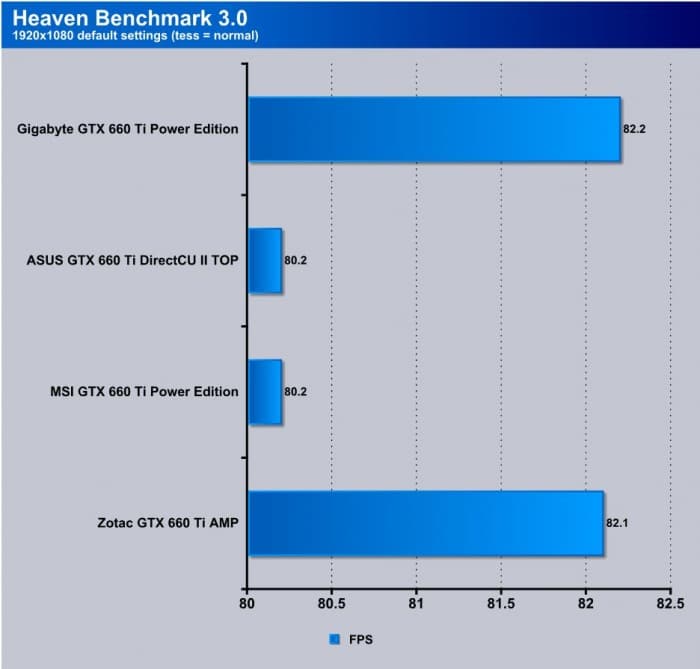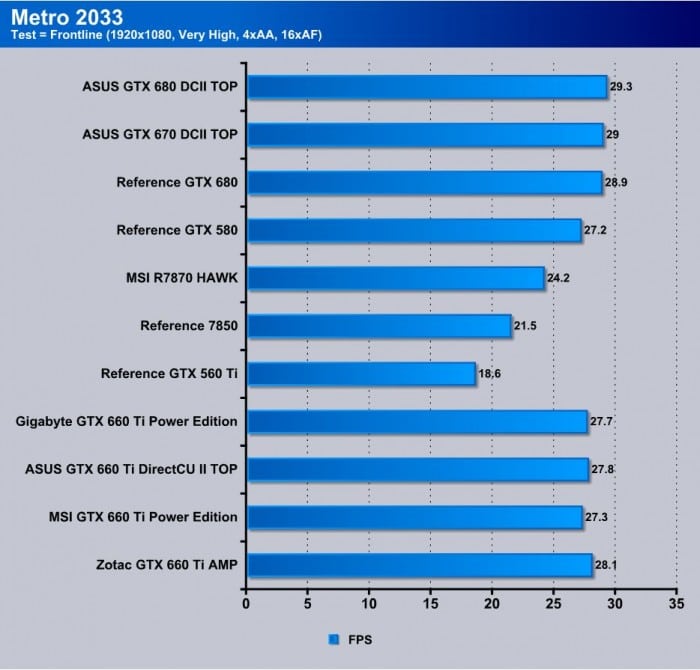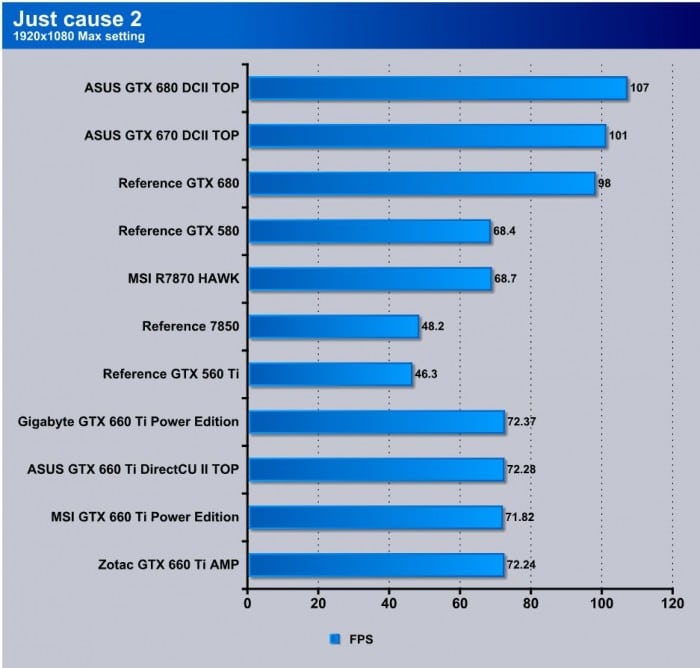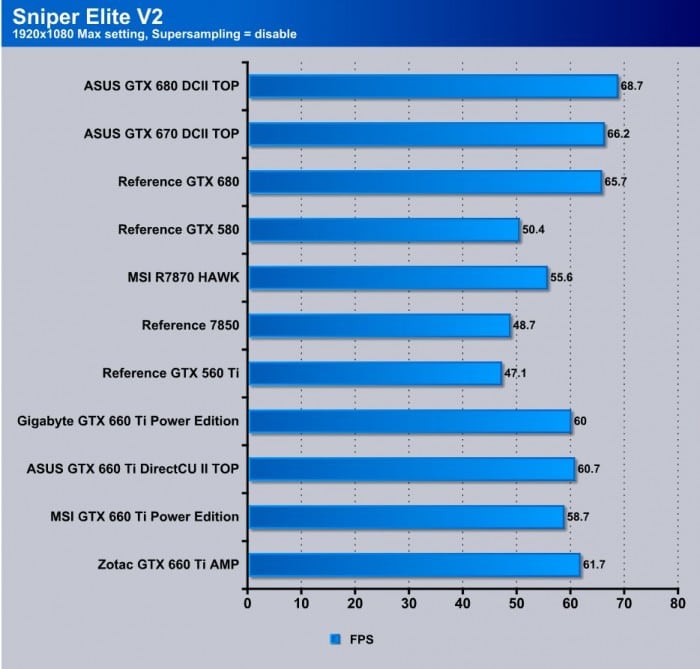GIGABYTE GeForce GTX 660 Ti Windforce OC
Testing & Methodology

We’ve expanded our testing suite considerably since the X79 chipset release, and will continue to use the same methods for most of the motherboards and CPU’s we test. In the interests of thoroughness and accurate results, we run each test at least three times, and some tests more than that. We average the total of all the tests from each benchmark then report the average here.
The OS we use is Windows 7 Pro 64bit with all patches and updates applied. We also use the latest drivers available for the motherboard and any devices attached to the computer. We do not disable background tasks or tweak the OS or system in any way. We turn off drive indexing and daily defragging. We also turn off Prefetch and Superfetch. This is not an attempt to produce bigger benchmark numbers. Drive indexing and defragging can interfere with testing and produce confusing numbers. If a test were to be run while a drive was being indexed or defragged, and then the same test was later run when these processes were off, the two results would be contradictory and erroneous. As we cannot control when defragging and indexing occur precisely enough to guarantee that they won’t interfere with testing, we opt to disable the features entirely.
Prefetch tries to predict what users will load the next time they boot the machine by caching the relevant files and storing them for later use. We want to learn how the program runs without any of the files being cached, and we disable it so that each test run we do not have to clear Prefetch to get accurate numbers. Lastly we disable Superfetch. Superfetch loads often-used programs into the memory. It is one of the reasons that Windows occupies so much memory. Vista fills the memory in an attempt to predict what users will load. Having one test run with files cached, and another test run with the files un-cached would result in inaccurate numbers. Again, since we can’t control its timings so precisely, it we turn it off. Because these four features can potentially interfere with benchmarking, and and are out of our control, we disable them. We do not disable anything else.
We are revamping our testing method in order to better represent motherboard performance and offering to the consumer. Also we want to make it an easier read for you without miles of endless charts. We ask that you provide feedback in an effort to help us deliver better reviews for you.
Test Rig
| Test Rig | |
| Case | Open Air Test Bench |
| CPU | Intel Core i7-3770K |
| Motherboard | GIGABYTE Z77X-UP5 TH |
| Ram | 16GB Patriot Viper Xtreme 2400MHz + |
| CPU Cooler | Swiftech H20-320 Edge |
| Hard Drive | Western Digital Velociraptor 300GB |
| SSD | Intel 510 series SATA III 120GB |
| Optical | ASUS BD-ROM |
| GPU | GIGABYTE GTX 660 Ti Windforce OC |
| Additional Cards |
N/A |
| PSU | Thermaltake Toughpower Grand 1200W |
| Mouse | Tt eSPORTS Black gaming mouse |
| Keyboard | Tt eSPORTS Meka G1 mechanical gaming keyboard |
Test Suite
We will use the following applications to test the performance of the graphics card.
Synthetic Benchmarks & Games
| Benchmarks |
|---|
| 3DMark11 |
| Just Cause 2 |
| Sniper Elite V2 |
| Metro 2033 |
| Unigine Heaven |
Note that due to time constraints all 660 Ti’s tested are all on the chart so you can compare to eht other models and teh marginal or in some cases not so marginal differences.
Overclocking

We were surprised by the GIGABYTE 660 Ti’s short-handedness. The GPU core fell a little short by approximately 10 MHz from the next leading competitor, and even more as you moved up spots. This left its boost clock 14 MHz behind its closest competitor and far behind the leader. This looks like luck of the draw as some of the 660’s we have tested are absolute gems to overclock and some are about average, and while this card is not bad, it is definitely not the best we have clocked. Once again this just goes to show that the CPU/GPU lottery is in effect.
| Clock | Max stable MHz |
| GPU Base clock | 1082 |
| GPU Boost Clock | 1160 |
| Max dynamic clock Observed | 1251 |
| Memory clock | 1755 (7020) |
The memory, on the other hand, is the absolute definition of flat out raw power, as it easily jumped past all of the competition settling in at over 7020 QDR (a little over 1GHz overclock QDR for the memory) which is huge! This kind of perfomance jump in some ways can definitely make up for the slightly lower GPU overclockability.
In order to ensure no system bottleneck we clocked the CPU to 4.6GHz to ensure there is no reason the system will slow down the cards performance at all.
Some may ask why we chose the mainstream Z77 system, and we can explain. Up until recent the X79 enthusiasts platform did not really support PCI-E Gen 3 on the Nvidia 600 series GPU’s. Because of the inherent instability many have seen with the X79 platform with Gen 3 products, Nvidia has been hesitant to enable it, and now there is a workaround via registry to get it working. However, in order to ensure the most consistent testing possible, we have stuck to the natively supported Z77 platform.
Important note: Overclocking can cause component failure. Please exercise caution when attempting any level of overclock on system components.
Temperatures

The temperatures were recorded with full loaded Heaven benchmark looping for over 30 minutes or longer depending how long it took for the card to level out in temps and sat at a plateau for more than 10 minutes.
| GPU Temperatures | Temperature (Idle/Load) |
| GIGABYTE GTX 660 Ti OC | 33C/72C |
| GIGABYTE GTX 660 Ti | 33C/70C |
The Windforce cooler did its job well and when pushed to full fan speed let out a mild whirring, but overall was not overly unpleasant. When left on auto we’re am betting it would be very difficult to even discern it from the other components in the system.
Real world/Gaming Benchmarks
3DMARK 11

3DMark 11 is the newest in Futuremark’s suite of benchmarking utilities. Its a fully capable DirectX11 benchmark which also stresses and analyzes the system performance as a whole to simulate a heavy rendering environment such as a high end game or other app the end user may run. This benchmark was run with Performance settings 5 times and all runs were averaged for the result below.
3DMark 11 shows a nice picture of the cards placement as it falls right behind the 670/680’s and well ahead of the 580. Now we just need some 7950’s to add to this mix. The GIGABYTE offering pulls a nice advantage here, and even though it is a small gain, it shows the raw power the GIGABYTE card harnesses as the card help quite consistent dynamic clocks compared to some of the others which tells us that internal tuning may be at play here as some tweaking likely was done behind the scenes to kee the card running strong under the consistent load.
Heaven Benchmark 3.0

Heaven Benchmark version 3.0 is the newest iteration from Unigine and a improvement to stability along with I am noticing much more consistent scoring as well.
In order to make sure we got these cards tested and up to show off to you guys we did not have time to retest our card suite in this newest benchmark, although we hope to update that very soon. Till then, you can compare the different 660 Ti’s we have here.
Metro 2033

Metro 2033 has always been extraordinarily stressful for GPU’s, and this has not changed with time. The 660 Ti cannot play Metro 2033 without minimum framerate, but for a midrange performance card it definitely holds its own as the previous generation flagship GTX580 is bested by this midrange beast. This round the GIGABYTE card is slightly off pace from the fastest but overall still a very fast card.
Just Cause 2

We brought a rather old but good game back for testing this card. Here the cards are neck and neck but the GIGABYTE pulls a slight lead for the win with the 660’s and, in this test the 660’s all trounce the 580 by a decent margin.
Sniper Elite V2
Those of you that have been paying attention to games recently will know that Sniper Elite V2 was recently released on the scene only a few months back. It is a fun game and once we found a benchmark tool we knew we had to put it in a review. The game is as it sounds: you are a sniper and your job is to sneak around and kill pretty much anything that moves. It has an x-ray mode that shows bones breaking or being shattered with hits.
Here the 660 Ti’s definitely shine as they clearly leap over the previous gen 580 again and from the looks of the FPS numbers this could be in or even beating the 7950 territory.
 Bjorn3D.com Bjorn3d.com – Satisfying Your Daily Tech Cravings Since 1996
Bjorn3D.com Bjorn3d.com – Satisfying Your Daily Tech Cravings Since 1996











